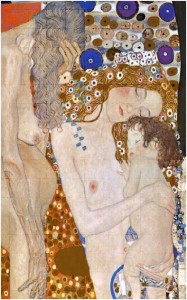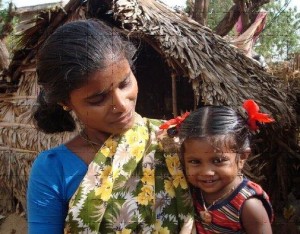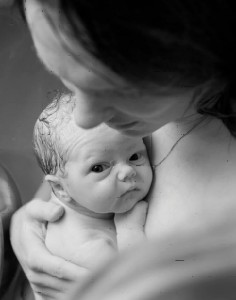
Childbirth As Initiation
By Julia Karadi
Provided by Nature
 |
The perinatal period (pregnancy, birth and postnatal) in a psychological understanding is a ’normative crisis’ in the female life cycle. Similarly to puberty and midlife crisis, it is also a transitional phase when crisis forms an inherent, natural part of personal development.2 In Western society these states of psychological crises have a negative connotation as something undesirable, something to avoid. Native and premodern societies, however, have different rituals to help transitional periods in life, viewing them as a natural, inherent part of personal development and growth whereby society supports the individual. The lack of community rites in modern societies imposes several difficulties on the person entering an age of transition. Adolescent boys unconsciously search their own individual ways to restore the lost pieces of collective rites in attempt of establishing a solid identity (by means of e.g. altered states of consciousness, tattooing, piercing, deviance, etc). With women, however, even rituals have never been so strictly regulated, as in their case, transitional periods are marked by tangible physiological changes like menstruation, menopause, pregnancy and birth.3 Can childbirth substitute the absent rituals of initiation in modern societies for women?The following paper will attempt to explore the answer to this question, by examining the psychology of the perinatal period. In the first chapter it will be shown how pregnancy and birth is a normative crisis in the female life cycle. After that, the meaning and significance of transitional life phases in the personal development will be examined by the theory of C. G. Jung. In the third chapter, parallels will be drawn between rituals of initiation and the process of childbirth to further explore and understand how birth can serve as initiation to women. Summarizing all examined processes will help to see the psychological significance of birth as initiation provided by nature. The last chapter will explore what are the conditions (internal and external) that can facilitate this invaluable experience.
1 Austin, 1990 in Molnár, 2004
2 Varga, Suhai, 2010
3 Eliade, 1959
Psychology of Pregnancy and Birth: a Normative Crisis
What do we know so far about the psychology of pregnancy and birth? What is happening in the psyche in this life phase? What is research and experience telling us about it?
However, in a women’s life cycle we know of three main transitional periods, puberty and the midlife crisis are much more commonly recognized as such than the perinatal period. These phases are also called ’normative crises’. Normative means that the crisis is a ’normal’, natural part of the developmental process that is crucial in order to successfully progress from one developmental stage to another.4 Crisis in this understanding is the way of the psyche to search and find a new balance when old patterns become outdated. Thus, it is not blocking – on the contrary – it serves personal development. During the perinatal period, psychological processes that take place are characteristics of the normative crisis. Why do pregnant women report on a growing intensity of emotions and sensitivity? Dreams and feelings are becoming stronger, emotional memories unexpectedly pop up from the past and all these play a much greater role in their lives than before. As the time of birth approaches, the urge intensifies to withdraw attention from the outside world and turn inwards to find shelter in a ’psychic bubble’ that is calling stronger than ever before.5
4 Erikson, 1968
This process of transformation can get so extreme that if it wasn’t for a pregnant woman, it would qualify pathological. As well as bodily as psychologically the old balance of homeostatic order is becoming fundamentally disrupted. However, in terms of the entire process, the transformation has it’s own inner purpose, logic and harmony. Research has shown6 that looking at the inner world of a pregnant woman, the experienced therapist suspects the onset of psychosis. Mental state of mothers-to-be were weekly tested by psychoanalytical tools (Rorschach test). The analysts, not knowing whose results they were looking at, were predicting a likely onset of psychosis. Follow-ups, however, showed that the research subjects were becoming completely healthy mothers. It is an inherent part of the natural process of transformation that the mental state of expectant mothers is coming out of balance. See Painless Childbirth
Psychologists report on a significantly shortened length and greater intensity of successful therapy in the perinatal period. Thanks to the availability of powerful psychic energies, so deep mental levels can instantly be reached that normally takes several years of therapeutic work. An altered state of consciousness is gradually becoming part of the everyday life of the expectant mother, often without being noticed and acknowledged by the woman herself and/or her environment.7 The lack of extensive knowledge and understanding of this meaningful process often leads to impatience and annoyance from both sides, or even fright of the unfamiliar. As these kind of unusual states of mind count as taboo in society – being exiled from the commonly accepted spectrum of reality – I believe, much more women have such experiences than who actually dare to openly talk about it. Average women in average hospital rooms can have birth experiences like the following:
„I felt the power of women in the space. I just couldn’t touch them with my two hands, but I definitely felt their presence. I felt that this primal force I’ve met is so powerful because it’s not mine, not personal. I just didn’t see these women, but I felt that I am in contact with them. I felt that if I would go more into it, I would even know their names.”8 Or another example:
5 Molnár, Frigyes, 2011
6 Parent-Infant Interaction. Ciba Foundation Symposium 33. (1975) Associated Scientific Publishers Amsterdam, In Varga, Suhai, 2010
7 Molnár, Frigyes, 2011
“Here I was, in a hospital, lying on my back giving birth, and suddenly this enormous spiritual force got going in me. I didn’t know it was a spiritual force at the time. It felt like being out of control. It felt like there were a lot of tremors, a lot of strange breathing that started to happen, kind of in spite of my best intentions. And I was both excited and very frightened by what was going on. This certainly was not what they had taught us about in childbirth preparation.“9
But unusual experiences can already happen during pregnancy, such as seeing or hearing the unborn child, which would be labelled as ‚hallucination‘ however it is part of a natural, meaningful process of psychological opening.
This process is universal. Each and every woman undergoes it to a certain extent whether or not she recognizes it, regardless of cultural background geographical location or historical period. What could be nature’s reason to provide women with such psychological crisis when carrying her child for nine months under her heart?
Crisis, development and the human psyche
For a deeper understanding of ecology and inherent meaning of the process, let’s have a short look at the structure and functioning of the human psyche as C. G.
Jung describes it after a lifetime of research.
The psyche consists of two complementary spheres, the conscious and the unconscious, which are divided further into two territories. It can be seen how little part of the psyche consciousness actually forms (white circle), suggesting how disproportionate the omnipotence that Western society attributes to it’s role. Consciousness is like a little island floating on the endless ocean of the subconscious territory of the psyche. The Ego (1.) forms it’s central point, which has the role to constantly monitor and adapt to the outside world. The function of Consciousness (2.) is to maintain communication between the Ego and other contents of the psyche. The Individual unconscious (3.) contains everything that is at the moment outside of conscious attention. The content of the Collective unconscious (4.) consists of universal human experiences, the so called ’archetypes’, such as the phases of a life cycle, like getting born, giving birth and dying.8 All quotes in this paper are taken from interviews with mothers on birth experiences, as part of my thesis research: Karádi, 20119 Interview with Christina Grof (http://www.intuition.org/txt/cgrof2.htm)10 Jakobi, 1973
Personal development is a process throughout the whole lifetime that Jung calls ’individuation’. It means to „become the essence of ourselves” more and more.11 The development leads through the process of reintegration between the conscious and unconscious territories of the psyche. „Jung considered that from birth every individual has an original sense of wholeness – of the Self – but that with development a separate ego-consciousness crystallizes out of the original feeling of unity.”12 As the ego is the center of consciousness, the Self can be understood as the center of the whole psyche, containing both the conscious and unconscious. Self is the main archetype, the hidden, inborn totality of the psyche. Personal development during a life-course (individuation) means that the ego fulfills it’s task to consciously rediscover the Self, one’s own inner center, the psychic nucleus.13
Transitional life-phases require the return to the sense of Self, as it is facilitated universally by myths, dreams, visions and rites of passage. The individual these times reaches a point in the course of development, an impasse where he/she has never been before, so the personal unconscious has no means to show the way out. The ego, thus, has to turn for help to the Self, this hidden regulating tendency, which often manifests in tales or myths as the old wise woman or hermit who is asked for guidance by the hero.
11Jakobi, 1973
12Henderson, 1978
13von Franz, 1978
In these periods of normative crisis, the old adaptive mechanisms of the ego become outdated, the inner world falls out of balance. Conscious control is losing power, the boundaries of the ego loosen up which leaves space for unconscious processes to strengthen. Dreams, feelings, memories and other unconscious contents of the psyche come closer to the surface, becoming more available for conscious attention. It is the task of the psyche these times to draw most of the attention back from the outside world and turn inwards. This temporary natural process of regression is however the symptom of crisis and confusion, it is also an instinctive mechanism of the psyche to restore and find new balance. The lack of strong conscious control in these periods leaves the individual without his/her ordinary defense mechanisms, causing a very fragile and sensitive state. Entering into a new life phase brings along new responsibilities, and the emergence of a new identity. The process of transition thus, – such as during the perinatal period – has a meaningful inner purpose, serving personal development.
The altered state of consciousness of expectant mothers – as discussed earlier – starts already from the beginning of pregnancy and lasts till about six months after birth. 14 Within this period the emotional world of the mother is characterized by an unusual psychological openness. As the conscious control is losing power, all boundaries open within the psyche, the „underwater world” is strengthening, leading towards a natural state of regression, turning inwards, intense sensibility, suggestibility and a strong sense of intuition.
Suggestibility means that the woman’s mind is like a sponge absorbing everything from the environment.15 As a side effect of the ego boundaries’ growing thin for a meaningful purpose, the usual conscious defense mechanisms weaken. The mother is exposed to suggestions (both positive and negative) affecting her state of mind in a much deeper way. This is why also the connotative meaning of words that are used by birth professionals are of great importance, such as ’contraction’, ’pain’, ’delivery’ or ’the sick one’ – as pregnant women are called within the medical system in some parts of the world. Common awareness of this psychological sensitivity in the perinatal period – peaking at birth – should be raised to avoid misunderstanding and mistreatment of expectant and birthing mothers by as well the environment as the women themselves.
14Molnár, Frigyes, 2011
15Varga, Suhai, 2010
One of the purpose and meaning in archaic societies to support phases of transition by rites of passage is to provide protection in these intensely sensitive periods. 16 Rituals offered a solid framework where the individual could temporarily be free from the urge of adaptation to the outside world, and surrender to the natural process of regression. As the subjects of initiation rituals enter into a transition from childhood to adulthood, women around their (first) pregnancies depart on a journey from womanhood towards motherhood. Examining the innate logic of the rituals we may gain a deeper understanding of the meaning and relevance of the perinatal processes in the personal development, in the process of individuation.
Childbirth and Initiation
16Eliade, 1959 – 17Van Gennep, 2010 – 18Eliade, 1959 The following table shows the common threefold structure of initiation rituals universally, and how parallels can be drawn with processes of transition, such as the first pregnancy, giving birth or getting born.
As tribal initiates depart from childhood and the process leads them through to adulthood, women in their first pregnancies grow from womanhood to motherhood. From this steady transition of pregnancy, we can zoom in on the process of birth, that takes place in the gate and shows a fractal-like similarity with the structure of the greater pattern. The fourth column of the table shows the baby’s perspective of the same process as we know from scientific evidence of perinatal psychology. 19 It is one of the greatest and most determining transition of our lives that leads from being a fetus to becoming a newborn, a journey „from womb to world” that we know now, „shapes our life” 20 and effects fundamentally how we experience later life-phases of transition. Within the framework of this paper only the parallels of the first and third column of the table will be further examined.
 |
19Grof, 1975
20Anna Verwaal (http://www.fromwombtoworld.com/)
Puberty rituals of initiation universally begin with rites of Separation from a previous world. 21 In this phase youngsters are separated from their old environment, women and children of the tribe and are led into the wilderness by men (in some places, they are covered by human blood). The meaning of this phase is a breakup with childhood, it’s symbolic significance is the act of detachment, displacement from a previous stage. Boys are mourned by their mothers and families as if they died.
What happens in this phase to the expectant mother? Her pregnant state is coming to an end as the contractions of the uterus begin, getting more and more intense and frequent by time. The cervix that until now had the task to close the way out, now slowly starts to soften, ripen and dilate. This is the first stage of labor. Similarly to the separation phase of rituals, a former state of equilibrium gets out of balance, a process of detachment begins.
Birthing women in this stage usually also physically separate from the world, and – ideally – with her chosen people of support, moves to her chosen place of birth, whether it is home, birth center or hospital. The process of separation however, doesn’t only take place physically, but also mentally. After the more social stage of early labor, in order to proceed to the active phase, the woman has to consciously surrender to the powers of labor. Her state of mind changes, her attention is drawn back from the outside world and turned more and more inwards as the gate begins to open in front of her fetus and psychologically also to herself.
The Liminal phase of tribal rituals marks a transition, a threshold between two places. Youngsters already left their previous identities, they don’t belong any more to their old group of boys, but they haven’t entered yet the new group of men. They thus ’levitate’ between two states. In this phase initiates have to endure procedures of sometimes extremely painful bodily sensations (such as circumcision, genital mutilations, tattooing, cutting in the skin, etc.) and they also receive in the wilderness for the first time the ancient, sacred knowledge of the tribe. Without identity, name and status, they have to surrender completely to the tribe leaders. The symbolic significance of the liminal phase is a ritual death and rebirth experience as they undergo a fundamental change in their existential condition.
21 Threefold structure of rites as described by Van Gennep and Eliade
In this stage, birthing women and tribal initiates are both characterized by humility and vulnerability. They have to surrender to a force that is greater than themselves, a challenging process and powerful bodily sensations of which they have no control over. Thus they have to give up their need for conscious control and let themselves be guided by a different kind of mental state.
Pain seem to have a crucial and meaningful role in both processes. Why is it, that wherever we look in the world, there is no initiation ritual to be found lacking the element of pain? What is the essential role that it plays in the process? Native people believed that their bodies are „being cut into pieces by initiating demon-masters”. 22 Personality of the initiates need to be decomposed in order for the parts to rebuild into a new unity. The child has to die in order to rebirth into a fertile, responsible adulthood. From a psychological perspective – as described earlier – the birthing mother, just like the initiate need to give up the will and desires of the ego-consciousness and surrender to the elemental force of the process. Symbolically, they need to let all boundaries of the psyche break down, to let the Ego perish into the infinity of the „underwater world” of the psyhe, the Self. In this understanding, rites of passage serve the purpose to bring the initiate back to the deepest level of ego-Self or mother-child unity by a symbolical death-rebirth experience.23
Saturation with the experience of pain is thus essential in order to reach the final limits, where – if the Ego capitulates – through complete self-surrender a turning point can happen in the process. Women often report on reaching a stage of impasse during birth. At a certain point they feel: „I can’t take it any more! I feel like being torn apart.”. Realizing that there is no way back, often in this dreadful psychological moment a turning point happens. The birthing mother realizes that it is resistance to the elemental power that creates suffering, and makes the process unbearable.
22Eliade, 195923Henderson, 1978Swinging over the threshold, the impasse, initiates and birthing women go through a psychological experience of death, which is the one and only way leading to rebirth. For the birthing mother it means even more that to hold her healthy newborn in her hands. While the closed gate in front of her fetus opens up to 10 cm’s, symbolically the same gate opens wide for her into the unknown. If she dares to cross that threshold, together with her fetus she is also reborn and initiated.
The last phase of the rite of passage is the incorporation into the new world. Initiates left as boys and now they re-enter society as men, with a new status and identity. Sometimes they even get a new name and learn a new language, emphasizing their irreversible new form of existence.
All in all, we’ve seen that childbirth and rituals of initiation show striking similarities. Not only in the threefold structure of the two parallel processes, but also in several psychological elements, such as the experience of pain or powerful bodily sensations, an altered state of consciousness, the trance-like state of ’laborland’, a symbolic experience of death and rebirth, self-transcendence, or an ecstatic feeling of unity,
 |
Psychological Significance of Birth as Initiation
The psychological significance of experiencing birth as an initiation ritual is fundamental. It does not only prepare the woman for the new identity and responsibilities of motherhood, but also creates an invaluable opportunity for personal development. In a Jungian understanding it is a crucial point in the process of individuation, of „becoming more the essence of ourselves”. The birthing mother, thus, does not only bring her baby to the world, but also herself. Herself as a competent mother with a strong intuitive bond to her child, and herself on a higher level of individuation with a deep sense of integrity within the psyche.
As described earlier, the perinatal period is a normative crisis in the course of women’s personal development. Such life phases of transition the individual has to face the unknown having to advance to a ’place’ where she has never been before. Therefore, neither the conscious parts of the psyche nor the individual unconscious can show the way out from the impasse. The ego has nothing left to do but to turn for help to the Self, the psychic nucleus, the hidden, inborn totality of the psyche. This is why the earlier described psychological processes of opening in the perinatal period are so meaningful: all boundaries within the psyche loosen up to give way to the unconscious processes to strengthen. The ego-consciousness needs to back up and give itself to the Self in order to make way for the inner growth of the personality.25 This is where birth is happening by nature. This is why women often report on an elemental force – that they have never felt before – coming to them during birth that is extremely powerful and feels greater than themselves. Due to lack of information and understanding, it can also become a frightening experience for her and/or her birth partners, that might hold her back from surrendering to this elemental force. However, this is what brings her child, along with herself on a new, higher level of psychic strength, health and integrity.
Furthermore, the experience is not only significant in regard to the psychological wellbeing and development of the mother, but also to that of the child. From evidence of perinatal psychology we know how deep the trace is that our own experience of getting born leaves on our psychological composition. It can become a hidden force that unconsciously leads the way we face and react to challenges in life, such as periods of transition. 26 An empowering birth experience thus creates a solid foundation for a healthy later development of the personality, and affects her own way of giving birth. In this way it may become a chain of positive effects having a deep psychological impact on the wellbeing of future generations.
Supporting the process
Having understood the fundamental significance of childbirth as initiation, it is important to see how we can actually enhance the experience. However – as described earlier – the physiological process in itself provides the initiation, by it’s very nature, it’s highly vulnerable and fragile. In our Western society – lacking community rites of passage – the protection and understanding of these sensitive life phases does not get sufficient attention.
What are the internal and external conditions that facilitate the experience of birth as initiation? First and foremost, both the environment and the birthing mother need to acknowledge the fact that birth is also a major inner, psychological process that she has to go through in order to bring her baby to the world.
Obviously, all mental and emotional processes of the mother (and baby) are accompanied by a complex and delicate hormonal orchestration, that can’t be discussed in detail within the framework of this paper.27 Evidence on hormonal physiology of childbirth confirms the following assumptions on a facilitating environment for birth as initiation. Above all, circumstances need to ensure a strong feeling of trust, safety and calm for the woman where she is not expected to react on any external stimulus so that she can feel free to give in to the urge of drawing all her attention inwards and surrender to the powerful waves of the process. This way she can saturate with the experience and can let all mental, bodily and emotional states surface, that need to manifest in the absence of conscious control. This implies also the least possible interventions, respect and no disturbance of her inner process, the ’birthing space’. Doulas and other experienced birth partners know how loving attention is often the greatest support that can help the mother do what she has to do and surrender to the vortex of the labor process.
s for internal conditions fr
26Orosz, 2009
27For further information, see e.g. http://www.sarahbuckley.com/
om the woman’s side, it is important to – already during pregnancy – be aware of and try to give in as much as possible to ’nature’s calling’ by a hormonal orchestration to focus inwards, to acknowledge the psychological process of regression as it has an invaluable purpose and meaning. Pregnancy is the time of preparation for body and soul when an inner work need to be done – giving way to the calling of introversion, intensification of dreams, feelings and memories, permeability of the borderline between conscious and unconscious territories. The process requires the development of skills that have to do with the flexibility of ego-boundaries, such as relaxation , self-surrender, reception, patience, acceptance or letting go. Even if it seems challenging in the beginning, we’ve seen how intense inner energies are available for preparation during pregnancy due to the loosening of the psychic boundary structure that support and speed up the process of transformation and development.
If women experience their birth as an initiation, it creates a fundamental change in their existential condition, which they often describe as follows: „It was a defining experience, since then I see the world differently. I simply arrived home. I was also getting born then.” All in all, both external and internal conditions need to be established to support the natural process of birth as initiation, letting nature take its course with all its beneficial and irreplaceable effects on both mother, baby and the wellbeing of coming generations.
Julia Karadi Childbirth as Initiation
_______________________________________________________________________________________________________________
BIBLIOGRAPHY
Eliade, M. (1958) Rites and Symbols of Initiation (Birth and Rebirth), London: Harvill Press.
Eliade, M. (1959) Myths, Dreams and Mysteries: the Encounter between Contemporary Faiths and Archaic Realities, London: Harvill Press.
Erikson, E. H. (1968). Identity: Youth and Crisis. New York: Norton.
Grof, Stanislav (1975). Realms of the Human Unconscious. New York: Viking.
Gaskin, I. M. (2003) Ina May’s Guide to Childbirth, Bantam.
Henderson, J. L. (1978). Ancient Myths and Modern Man in Jung, C. G. ed., Man and his Symbols
Jacobi, J. (1973). The psychology of C. G. Jung: An introduction with illustrations. New Haven: Yale University Press.
Karádi, J. (2011) Az „elég jó“ szülés, mint természet adta beavatási rítus.
Diplomamunka, ELTE, Budapest.
Molnár J., Frigyes, J. (2011) A mesterséges megtermékenyítéstől a szülés utáni depresszióig – A szülészet pszichológiai-pszichiátriai problémái és terápiás eszköztára. Vadaskert Kórház akkreditált továbbképzése.
Orosz, K. (2009) Magzatból emberré válni – az élet elfogadása. 10th Congres of Hungarian Pre- and Perinatal Psychology Association
Van Gennep, A. (2010). The Rites of Passage. Routledge Chapman & Hal.
Varga, K, Suhai G. (2010) Szülés és születés. Lélektanon innen és túl. Budapest, Pólya
Von Franz, M. L. (1978) The Process of Individuation in Jung, C. G. ed., Man and his Symbols. London.







